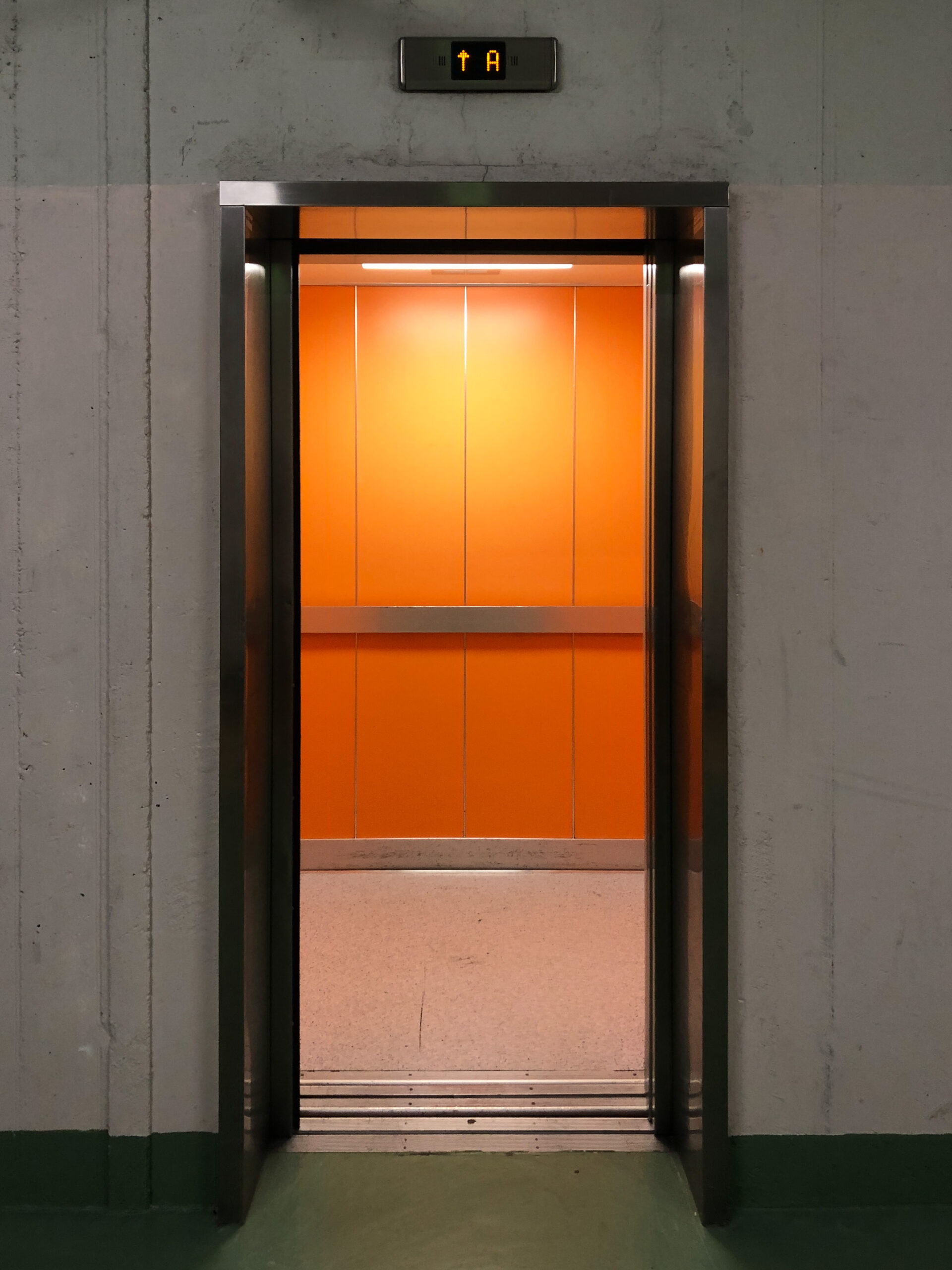spaces from inside to outside, from small to big.
Space 1: elevator, HIL

Basic geometry: box-like shape. Linoleum floor, plastic walls and plaster ceiling.
The main purpose of the elevator is to transport people between floors. They have to be big enough to allow things to be transported, but not too big that they don’t take up too much space.
In terms of acoustics, the elevators came to mind because they are relatively small spaces on campus, like small capsules. When you speak, the sound seems very close and dense, even if you are only whispering softly. It almost acts like an amplification of the voice. It seems relatively loud.
Acoustic events:
- Flat box-like walls create a short reverberation. It is short because the room is and sounds small. The acoustic property seems boxy: The dense reverberation comes right after the sound and is not there for long.
- Speaking seems loud, almost amplified because of the reverberation. You can hear and understand the spoken word very clearly.
- When you clap, it seems medium-loud, it does not reverberate for long.
Additional considerations:
- Common ambient sounds are the mechanics of the elevator itself like a whirring and the people you hear talking as you pass the floors. One seems enveloped, one hears the sounds muffled.
Space 2: staircase to parking garage, HIL
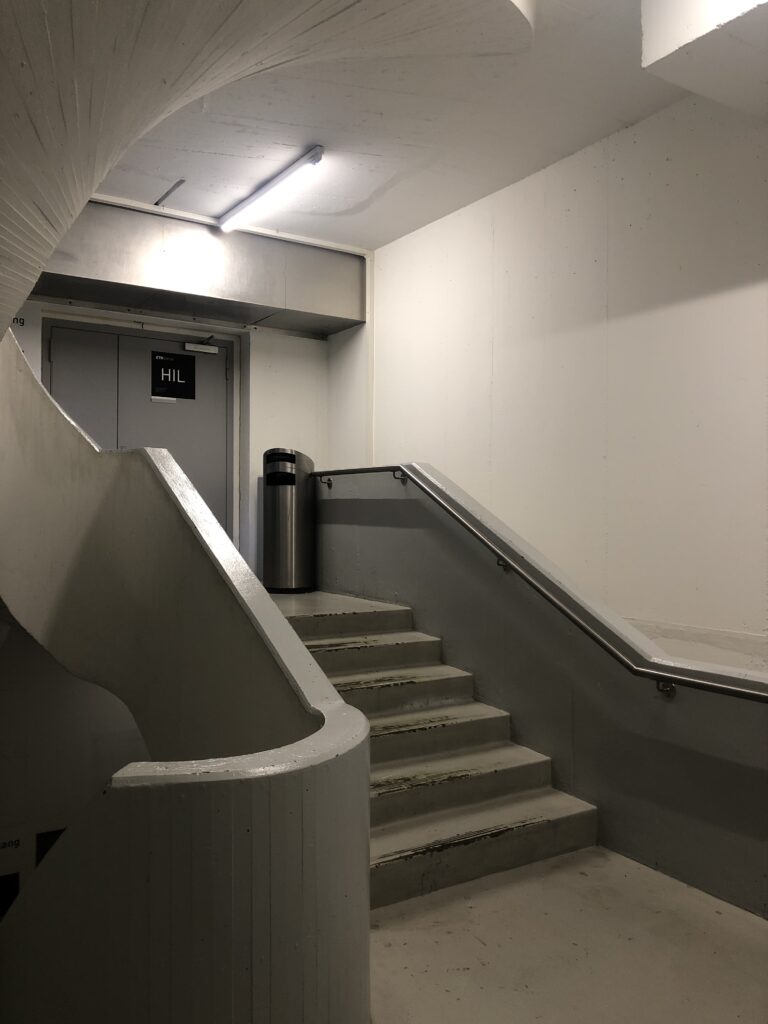
Basic geometry: a cylinder with an open top and a round staircase inside. mostly concrete.
The main purpose of this space is to lead the way via the stairs into the car parking lot. It is a space between inside and outside: It has to be weather-resistant and easy to clean.
This staircase stuck to me acoustically because the reverberation of the voice and the footsteps is intense. When you speak, the sound diffuses into the space and reverbs a long time. It feels hollow and cold.
Acoustic events:
- diffusion of sound: different reflections of sound.
- A very long reverberation: Cause of the non-absorbent concrete walls, the sound is reverberated longer and the spaces seems large, almost church-like.
- Harsh acoustic properties: They are characterized by excessive high-frequency reflections. And are caused by the presence of hard, reflective surfaces like the concrete here and a lack of acoustic treatment designed to absorb or diffuse sound waves.
- When you clap, the sound of it is loud and reverberates for a long time in high frequency, almost 3 seconds in a weavy-sound, a bit echoy.
- When speaking silently, you can clearly hear the voice and the long reverberation of the higher frequencys. If more than one were to speak, it would be hard to understand each other due to the long reverberation.
Additional considerations:
- Ambient sounds consist of the car sound of the nearby streets and the buzzing sound of construction site outside. The are not muffled as in the elevator, more clear, but far away.
Space 3: outside space, HCP
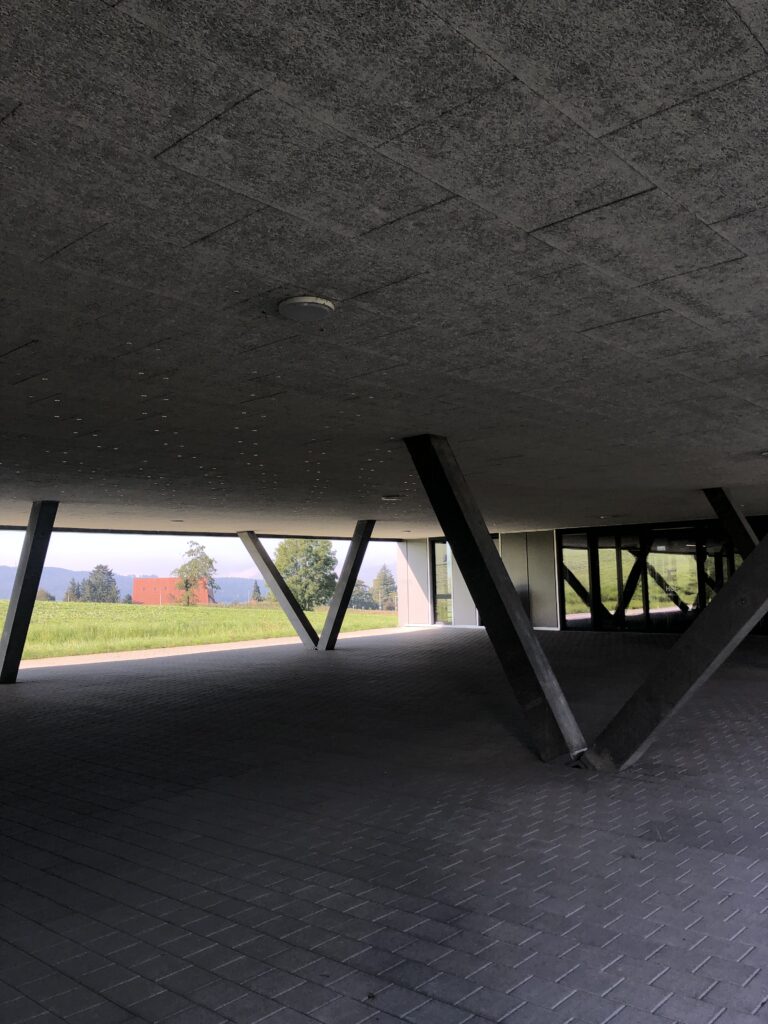
Basic geometry: a big flat cuboid form where two of the longer sides are open horizontally to the surroundings. hard surfaces.
The main purpose of this public outdoor space is to offer covered space to enter the building and maybe take breaks outside. Also, there is a bicycle parking. V-shaped beams carry the load of the building on top and create atmosphere. You can access the space from one open side via the gravel road, while the other open side provides a view to the green fields.
This open space is interesting because of the large, flat geometry.
Acoustic events:
- If you clap loudly, a harsh high-pitched flatter-echo occurs. It ping-pongs from one closed side to the other. Clapping on one side of the space, the flatter sound is louder on the other side. It’s like a vibration or scintillation in the ears.
- The spoken word is clear and understandable but not loud. I would have to speak louder if a crowd of people were listening.
Additional considerations:
- The surrounding acoustic ambient sounds are the chirping of the birds on the fields and the faraway rumbling of the street.
01 Exploring the Emotional Impact of Everyday Sounds
Space 1: elevator, HIL
Specific Sounds, manmade:
- High-fequency Whirring sound of the mechanics parts in the elevator.
- A kind of slow sound with low and at the same time high squeaking frequencies. It is the result of something rotating.
- You also can hear very muffled the people talking as you pass by the floors.
- One seems enveloped in this cell.
In general, the sounds are not too loud, except for the sound when the door opens. You hear a dull rolling sound with low tones. Further, you hear something squeaking, as if you were walking on a slippery floor with wet rubber soles – but this one is a rotating squeak. When you pass the F-floor, you hear a metallic thud, perhaps some kind of rope, with a medium-high frequency, which resounds into the lift shaft. I suppose this might be the most overheard sound. Arriving on the lowest floor, floor A, the door opens to corridors where you can hear the water pipes splashing.
The sounds start quietly, becomes more intense as you accelerate and then slows down – the lift door falls open with a squeak and a loud crash. This variation makes you acutely aware that you are in a lift and how fast it is going. This gives you a sense of security because you know what is going to happen. If I didn’t hear any sounds at all, if I was more isolated, you wouldn’t be so aware of it. You become most emotionally active when the door bursts open.
Sounds that would discomfort me include abnormal noises from the elevator. For example, if the whirring suddenly became excessively loud or if a completely new and unfamiliar sound emerged. Also, if you would suddenly hear people outside shouting or talking louder. These two points would indicate some kind of danger. Another unpleasant sound could be a high-pitched squeaking noise, which is uncomfortable for the ears. So to conclude, something that is:
- sudden
- abnormal
- loud
- different rhythm / pattern
- absense of sound
- unpleasant for ears
Space 2: staircase to the parking garage, HIL
02 Empirical and numerical estimation of room acoustic properties.
Space 1: elevator, HIL

RT60 = 0.245 x 2 = 0.49
I’m unsure about the calculation online. What did I do wrong? It does not give me any output.
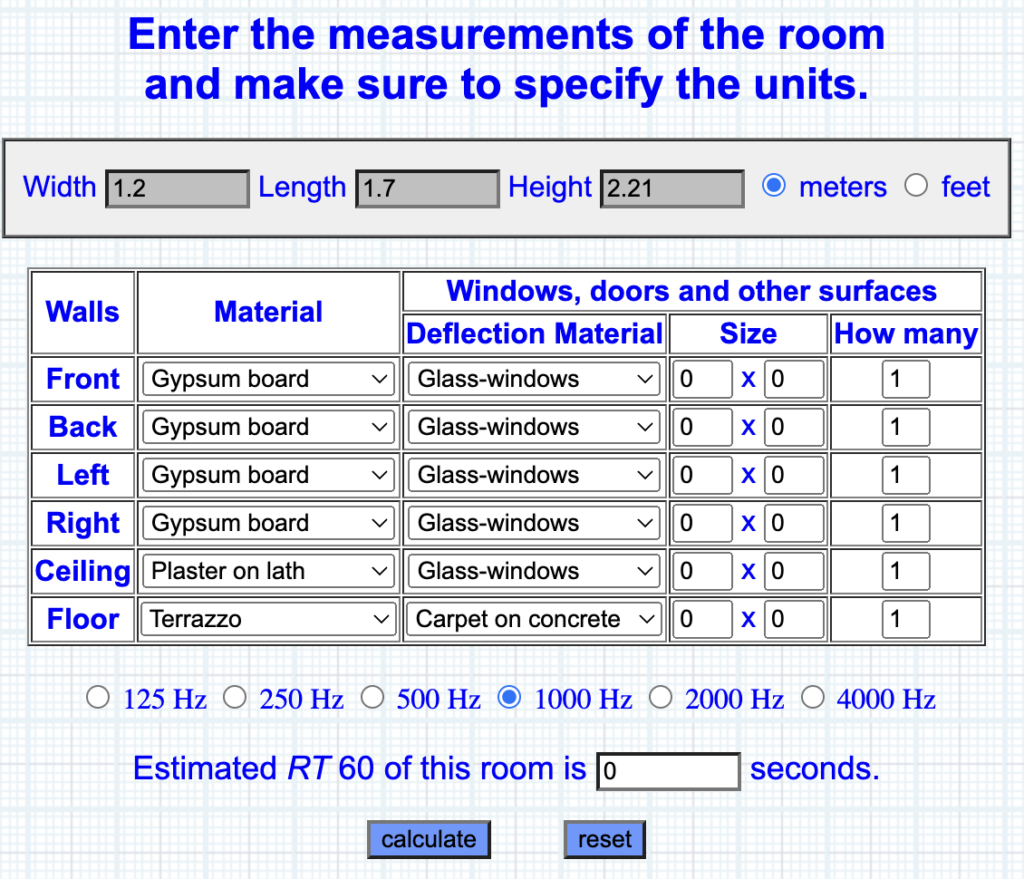
Space 2: staircase to parking garage, HIL

RT60 = 1.468 x 2 = 2.94
Space 3: outside space, HCP
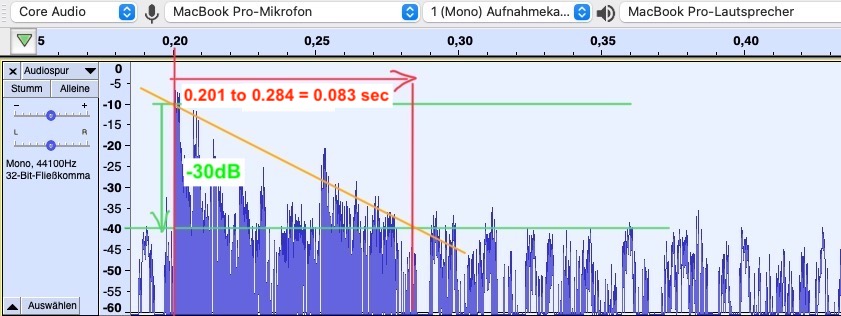
RT60 = 0.083 x 2 = 0.166
The echo is clearly visible in the diagram!
There is practically no reverberation in this outside space and also alot of surrounding sounds. This makes it really hard to estimate the RT.
03 Characterization of room acoustic treatments
Space 1: elevator, HIL
Basic geometry: box-like shape. Linoleum floor, plastic walls and plaster ceiling.
There are no effective elements (absorbers) located in the elevator. More textile-like materials could favour the diffuse reflection of sound. I think that most of the materials used in here are very reflective, as they are completely flat.
Space 2: staircase to the parking garage, HIL
Basic geometry: a zylinder with an open top and a round staircase inside. mostly concrete.
Again, no absorbers were installed in this space. All surfaces are flat concrete and reflect a lot of sound.
Space 3: outside space, HCP
Basic geometry: a big flat cuboid form where two of the longer sides are open horizontally to the surroundings.
This outside space is also made out of a lot of reflective surfaces. The flat glass sides, the floor and the ceiling are all hard surfaces. Not quite sure, if the ceiling may absorb sound a bit better, cause of its uneven texture.

